|
|
 Get the latest Java books |
|
|
h t t p : / /w w w . j a v a c o f f e e b r e a k . c
o m /
|
||
New to Java? We'll help you get started with our revised beginner's tutorial, or our free online textbook.
|
|
 Get the latest Java books |
|
|
h t t p : / /w w w . j a v a c o f f e e b r e a k . c
o m /
|
||
Contents
A client will only be looking for an implementation of an interface. The implementation can be done in many different ways, discussed in this chapter.
One extreme is where the proxy is so fat, that there is nothing left to do on
the server side. The role of the server is to register the proxy with service
locators, and just to stay alive (renewing leases on the service locators).
The service itself runs entirely within the client.
A class diagram for the file classifier problem using this method is
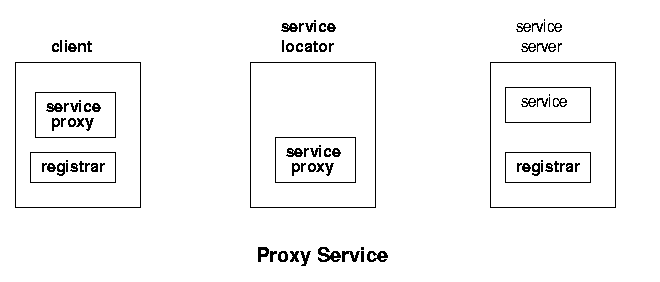
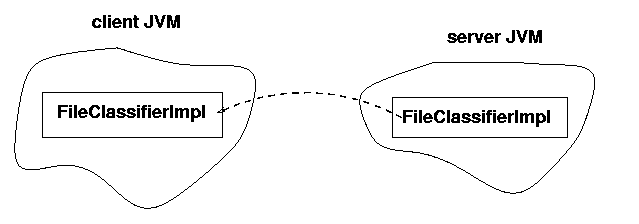
The client asks for a FileClassifier. What is uploaded to the service
locators, and so what the client gets, is a FileClassifierImpl.
The FileClassifierImpl runs entirely within the client, and does
not communicate back to its server at all. This can also be done for any
service, when the service
is purely a software one which does not need any link back to the server. It could
be something like a calendar which is independent of location, or a diary which
uses files on the client side rather than the server side.
The opposite extreme to this is where all of the processing is done on the server side. The proxy just exists on the client to take calls from the client, invoke the method in the service on the server, and return the result to the client. Java's RMI does this in a fairly transparent way (once all the correct files and additional servers are set up!)
A class diagram for an implementation of the file classifier using this
mechanism is
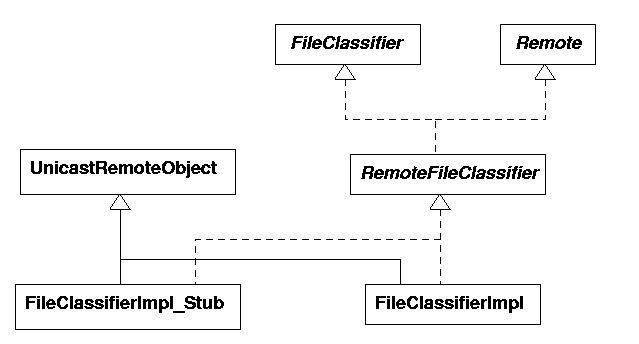
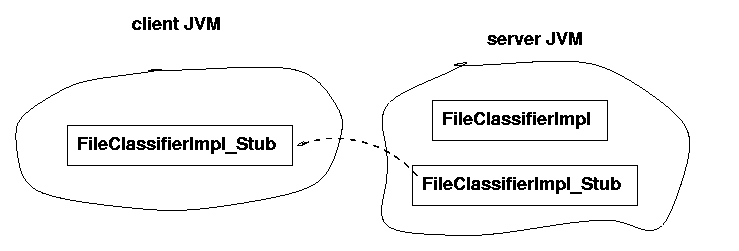
The class structure for this is much more complex in order to get RMI to work.
The interface RemoteFileClassifier has to be defined, and the
implementation class has to implement (or call suitable methods from) the
UnicastRemoteObject class.
The FileClassifierImpl_Stub is generated from
FileClassifierImpl by use of the rmic compiler.
Implementing the Remote
interface allows the methods of the FileClassifierImpl to be
called remotely. Inheriting from UnicastRemoteObject allows RMI to
export the stub rather than the service, which remains on the server.
Apart from creating the stub class by using rmic, the stub
is essentially invisible to the programmer: the server code is written to
export the implementation, but the RMI runtime component of Java recognises
this and actually exports the stub instead. This can cause a little confusion:
the programmer writes code to export an object of one class, but an object
of a different one appears in the service locator and in the client.
This structure is useful when the service needs to do no processing on the client side, but does need to do a lot on the server side. For example, a diary that stores all information communally on the server rather than individually on each client. Services that are tightly linked to a piece of hardware on the server are other cases.
If RMI is not used and the proxy and service want to share processing, then
both the service and the
proxy must be created explicitly on the server side. The proxy is explicitly exported
by the server and must implement the interface. But on the server side this
requirement does not hold, since the proxy and service are not tightly linked
by a class structure any more. The class diagram for the file classifier with
this organisation is
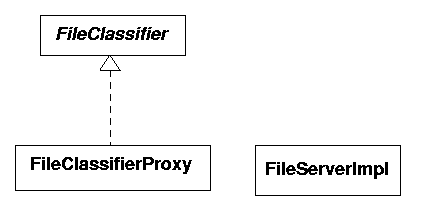
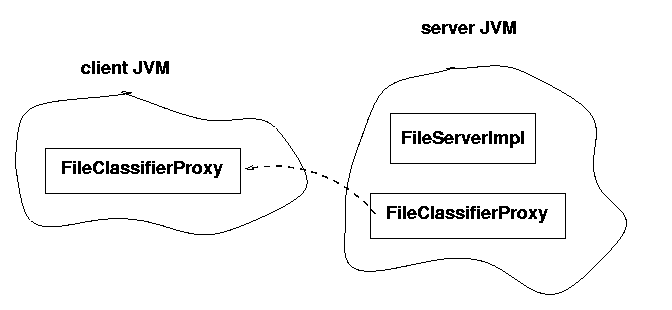
This doesn't specify how the proxy and the server communicate. They could open up a socket connection, for example and exchange messages using a message structure only they understand. Or they could communicate using a well-known protocol, such as HTTP for example: the proxy could make HTTP requests, and the service could act as an HTTP server handling these requests and returning documents. A version of the file classifier using sockets to communicate is given in the section ``Non-RMI Proxy for FileClassifier''.
This model is good for bringing ``legacy'' client-server applications into the Jini world. Client-server applications often communicate using a specialised protocol between the client and server. Copies of the client have to be distributed out to all machines. If there is a bug in the client, they all have to be updated which is often impossible. Worse, if there is a change to the procotol, then the server must be rebuilt to handle old and new versions while attempts are made to update all the clients. This is a tremendous problem with Web browsers for example, with varying degrees of support for HTML 3.2 and HTML 4.0 features, let alone new protocol extensions such as stylesheets and XML. CGI scripts that attempt to deliver the ``right'' version of documents to various browsers are clumsy but necessary hacks.
What can be done instead is to distribute a ``shell'' client, that just contacts the server and uploads a proxy. The proxy is the real ``heart'' of the client, whereas the service is the server part of the original client-server system. When changes occur, the service and its proxy can be updated together, and there is no need to make changes to the ``shell' out on all the various machines.
The last variation is to have a service, an explicit proxy and an RMI proxy. Both of the proxies are exported: the explicit proxy has to be exported by registering it with lookup services, while the RMI proxy is exported by the RMI runtime mechanisms. The RMI proxy can be used for RPC-like communication mechanism between the explicit proxy and the service. This is just like the last case, but instead of requiring the proxy and service to implement their own communication protocol, it uses RMI instead. The proxy and service can be of any relative size, just like in the last case. What this does is to simplify the task of the programmer.
In the later section ``RMI and non-RMI Proxies for FileClassifier'' there is a
non-RMI proxy FileClassifierProxy implementing the
FileClassifier interface. This communicates with an object
which implements the ExtendedFileClassifier interface.
There is an object on the server of type ExtendedFileClassifierImpl
and an RMI proxy for this on the client side of type
ExtendedFileClassifierImpl_Stub
The class diagram is
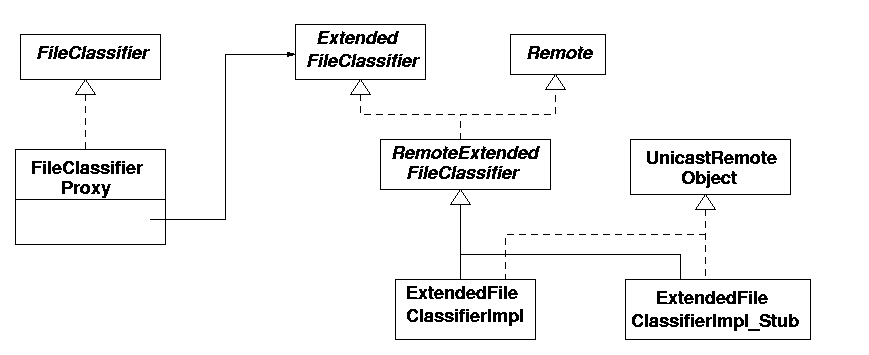
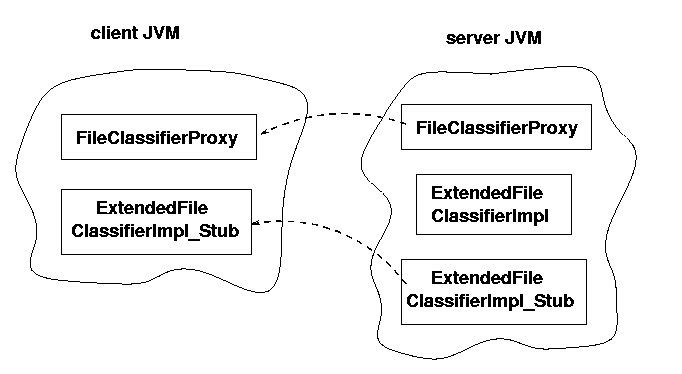
An RMI proxy can be used when all of the work done by the service is done on the server side. Then the server exports a thin proxy that simply channels method calls from the client across the network to the ``real'' service in the server, and returns the result back to the client. The programming for this is relatively simple. The service has to do two major things in its class structure:
Remote. This is because methods will be called
on the service from the proxy, and these will be remote calls on the
service
UnicastRemoteObject (or Activatable).
This means that its constructor will create and export a proxy or stub
object, without the programmer having to do anything more. (An alternative
to inheritance is for the object to call the
UnicastRemoteObject.exportObject() method.)
The client is not concerned about the implementation of the service at all,
and doesn't change. The FileClassifier interface doesn't change
either, since this is fixed and used by any client and any service implementation.
We have already declared its methods to throw RemoteException
so a proxy is able to call its methods remotely.
And the MIMEType doesn't change since we have already declared
it to implement Serializable - it is passed back across the
network from the service to its proxy
The implementation will need to implement both the FileClassifier
and the Remote interface. It is convenient to define another
interface RemoteFileClassifier just to do this.
package rmi;
import common.FileClassifier;
import java.rmi.Remote;
/**
* RemoteFileClassifier.java
*/
public interface RemoteFileClassifier extends FileClassifier, Remote {
} // RemoteFileClasssifier
The service itself will look like
package rmi;
import java.rmi.server.UnicastRemoteObject;
import common.MIMEType;
import common.FileClassifier;
/**
* FileClassifierImpl.java
*/
public class FileClassifierImpl extends UnicastRemoteObject
implements RemoteFileClassifier {
public MIMEType getMIMEType(String fileName)
throws java.rmi.RemoteException {
System.out.println("Called with " + fileName);
if (fileName.endsWith(".gif")) {
return new MIMEType("image", "gif");
} else if (fileName.endsWith(".jpeg")) {
return new MIMEType("image", "jpeg");
} else if (fileName.endsWith(".mpg")) {
return new MIMEType("video", "mpeg");
} else if (fileName.endsWith(".txt")) {
return new MIMEType("text", "plain");
} else if (fileName.endsWith(".html")) {
return new MIMEType("text", "html");
} else
// fill in lots of other types,
// but eventually give up and
return new MIMEType(null, null);
}
public FileClassifierImpl() throws java.rmi.RemoteException {
// empty constructor required by RMI
}
} // FileClassifierImpl
The server appears to change very little from one that exports a complete
service. It exports a service object by register(), but at
that point the RMI runtime intervenes and changes this into an RMI stub
object. The other major change is that the server no longer needs to
explicitly stay alive. While the RMI system keeps a reference to the
RMI stub object, it keeps the JVM alive that contains the stub object.
This means that the daemon threads which are looking after the discovery
process will continue to run, and in turn, since they have a reference
to the server as listener it will continue to exist.
A server which creates and manages the RMI service is
package rmi;
import rmi.FileClassifierImpl;
import rmi.RemoteFileClassifier;
import net.jini.discovery.LookupDiscovery;
import net.jini.discovery.DiscoveryListener;
import net.jini.discovery.DiscoveryEvent;
import net.jini.core.lookup.ServiceRegistrar;
import net.jini.core.lookup.ServiceItem;
import net.jini.core.lookup.ServiceRegistration;
import net.jini.core.lease.Lease;
// import com.sun.jini.lease.LeaseRenewalManager;
// import com.sun.jini.lease.LeaseListener;
// import com.sun.jini.lease.LeaseRenewalEvent;
import net.jini.lease.LeaseRenewalManager;
import net.jini.lease.LeaseListener;
import net.jini.lease.LeaseRenewalEvent;
import java.rmi.RMISecurityManager;
/**
* FileClassifierServer.java
*/
public class FileClassifierServerRMI implements DiscoveryListener, LeaseListener {
protected FileClassifierImpl impl;
protected LeaseRenewalManager leaseManager = new LeaseRenewalManager();
public static void main(String argv[]) {
new FileClassifierServerRMI();
// no need to keep server alive, RMI will do that
}
public FileClassifierServerRMI() {
try {
impl = new FileClassifierImpl();
} catch(Exception e) {
System.err.println("New impl: " + e.toString());
System.exit(1);
}
// install suitable security manager
System.setSecurityManager(new RMISecurityManager());
LookupDiscovery discover = null;
try {
discover = new LookupDiscovery(LookupDiscovery.ALL_GROUPS);
} catch(Exception e) {
System.err.println(e.toString());
System.exit(1);
}
discover.addDiscoveryListener(this);
}
public void discovered(DiscoveryEvent evt) {
ServiceRegistrar[] registrars = evt.getRegistrars();
RemoteFileClassifier service;
for (int n = 0; n < registrars.length; n++) {
ServiceRegistrar registrar = registrars[n];
// export the proxy service
ServiceItem item = new ServiceItem(null,
impl,
null);
ServiceRegistration reg = null;
try {
reg = registrar.register(item, Lease.FOREVER);
} catch(java.rmi.RemoteException e) {
System.err.print("Register exception: ");
e.printStackTrace();
// System.exit(2);
continue;
}
try {
System.out.println("service registered at " +
registrar.getLocator().getHost());
} catch(Exception e) {
}
leaseManager.renewUntil(reg.getLease(), Lease.FOREVER, this);
}
}
public void discarded(DiscoveryEvent evt) {
}
public void notify(LeaseRenewalEvent evt) {
System.out.println("Lease expired " + evt.toString());
}
} // FileClassifierServerRMI
We have the classes
common.MIMEType
common.FileClassifier
rmi.RemoteFileClassifier
rmi.FileClassifierImpl
rmi.FileClassifierImpl_Stub
rmi.FileClassifierServer
client.TestFileClassifier
FileClassifierImpl_Stub is added to our classes by
rmic as discussed in the next section.)
These could be running on upto four different machines
FileClassifierServer
TestFileClassifier
The server running FileClassifierServer needs to know the
following classes and interfaces
common.FileClassifier interface
rmi.RemoteFileClassifier interface
common.MIMEType
rmi.FileClassifierServer
rmi.FileClassifierImpl
The lookup service does not need to know any
of these classes. It just deals with them in the form of a
java.rmi.MarshalledObject
The client needs to know
common.FileClassifier interface
common.MIMEType
In addition, the HTTP server needs to be able to load and store classes. It needs to be able to access
rmi.FileClassifierImpl_Stub interface
rmi.RemoteFileClassifier interface
common.FileClassifier interface
common.MIMEType
FileClassifierProxy constructor,
the class FileClassifierImpl
is passed in. The RMI runtime converts this to
FileClassifierImpl_Stub. This class implements the same
interfaces as FileClassifierImpl: that is,
RemoteFileClassifier and hence FileClassifier,
so these also need to be available. In the implementation,
FileClassifierImpl references the class
MIMEType, so this must also be available.
What does the phrase ``available'' mean in the last paragraph?
The HTTP server will look for files based on the
java.rmi.server.codebase
property of the application server. The value of this
property is a URL. Often, URLs can be file or
http references.
But for this case, the URL will be used by clients running anywhere,
so it cannot be a file reference specific to a particular machine.
For the same reason, it cannot be just localhost - unless
you are running every part of a Jini federation on a single computer!
If java.rmi.server.codebase is
an http reference, then the above class files must be accessible from
that reference. For example, suppose the property is set to
java.rmi.server.codebase=http://myWebHost/classes
myWebHost is the name of the HTTP server's host)
and this Web server has its DocumentRoot
set to /home/webdocs
then these files must exist
/home/webdocs/classes/rmi/FileClassifierImpl_Stub.class
/home/webdocs/classes/rmi/RemoteFileClassifier.class
/home/webdocs/classes/common/FileClassifier.class
/home/webdocs/classes/common/MIMEType.class
Again we have a server and a client to run.
Calling the client is unchanged from the situation discussed in the
previous chapter using the server in the complete package,
since the client is independant of any server implementation
java -Djava.security.policy=policy.all client.TestFileClassifier
The server is more complex, because the RMI runtime is manipulating
RMI stubs, and these have additional requirements.
Firstly, RMI stubs must be generated during compilation.
Secondly, security rights must be set since an
RMISecurityManager is used.
Although the FileClassifierImpl is created explicitly
by the server, it is not this class
file that is moved around. It continues to exist on the server
machine. Rather, a stub file is moved around,
and will run on the client machine. This stub is responsible for
sending the method requests back to the implementation class
on the server. This stub has to be generated from the implementation
class by the stub compiler rmic:
rmic -v1.2 -d /home/webdocs/classes rmi.FileClassifierImpl
-v1.2 option says to generate JDK 1.2 stubs
only, and the -d option says where to place the resultant
stub class files so that they can be located by the HTTP server
(in this case, in the local file system).
Note that the pathnames for directories here and later do not include
the package name of the class files. The class files (here
FileClassifierImpl_Stub.class) will be placed/looked
for in the appropriate subdirectories.
The value of java.rmi.server.codebase must specify the
protocol used by the HTTP server to find the class files. This could
be the file protocol or the http protocol.
If the class files are
stored on my Web server's pages under
classes/rmi/FileClassifierImpl_Stub.class.
the codebase would be specified as
java.rmi.server.codebase=http://myWebHost/classes/
myWebHost is the name of the HTTP's server host).
The server also sets a security manager. This is a restrictive one,
so it needs to be told to allow access. This can be done by setting
the property java.security.policy to point to a
security policy file such as policy.all.
Combining all these points leads to startups such as
java -Djava.rmi.server.codebase=http://myWebHost/classes/ \
-Djava.security.policy=policy.all \
rmi.FileClassifierServer
Many client-server programs communicate by message passing, often using a TCP socket. The two sides need to have an agreed protocol, that is they must have a standard set of message formats, and know what messages to receive and what replies to send at any time. Jini can be used in this sort of case by providing a wrapper around the client and server, and making them available as a Jini service. The original client then becomes a proxy agent for the server, and is distributed to Jini clients for execution. The original server runs within the Jini server and performs the real work of the service, just as in the thin proxy model. What differs is the class structure and how the components communicate.
The proxy and the service do not need to belong to the same class, or even
share common superclasses. Unlike the RMI case, the proxy is not derived
from the service so does not have a shared class structure. Both are written
independently, using their own appropriate class hierarchies. The proxy
still has to implement the FileClassifier interface, since that
is what the client is asking for and the proxy is delivering.
If RMI is not used, then any other distributed communication mechanism can be employed. Typically client-server systems will use something like reliable TCP ports, but this is not the only choice. It is the one used in this example, though. So the service listens on an agreed port, the client connects to this port, and they exchange messages.
The message format adopted for this problem is really simple:
"null" followed by a
newline. If it succeeds, it sends two lines, the first being the
content type, the second the subtype.
null
or a new MIMEType object.
The proxy object will be exported completely to a Jini client such as
TestFileClassifier. When this client calls the
getMIMEType() method, the proxy opens up a connection on an
agreed TCP port to
the service and exchanges messages on this port. It then returns a
suitable result. The code is
package socket;
import common.FileClassifier;
import common.MIMEType;
import java.net.Socket;
import java.io.Serializable;
import java.io.IOException;
import java.rmi.Naming;
import java.io.*;
/**
* FileClassifierProxy
*/
public class FileClassifierProxy implements FileClassifier, Serializable {
static public final int PORT = 2981;
protected String host;
public FileClassifierProxy(String host) {
this.host = host;
}
public MIMEType getMIMEType(String fileName)
throws java.rmi.RemoteException {
// open a connection to the service on port XXX
int dotIndex = fileName.lastIndexOf('.');
if (dotIndex == -1 || dotIndex + 1 == fileName.length()) {
// can't find suitable index
return null;
}
String fileExtension = fileName.substring(dotIndex + 1);
// open a client socket connection
Socket socket = null;
try {
socket = new Socket(host, PORT);
} catch(Exception e) {
return null;
}
String type = null;
String subType = null;
/*
* protocol:
* Write: file extension
* Read: "null" + '\n'
* type + '\n' + subtype + '\n'
*/
try {
InputStreamReader inputReader =
new InputStreamReader(socket.getInputStream());
BufferedReader reader = new BufferedReader(inputReader);
OutputStreamWriter outputWriter =
new OutputStreamWriter(socket.getOutputStream());
BufferedWriter writer = new BufferedWriter(outputWriter);
writer.write(fileExtension);
writer.newLine();
writer.flush();
type = reader.readLine();
if (type.equals("null")) {
return null;
}
subType = reader.readLine();
} catch(IOException e) {
return null;
}
// and finally
return new MIMEType(type, subType);
}
} // FileClassifierProxy
On the server side will be running the service. This will run in its own
thread (inheriting from Thread) and will listen for connections.
When one is received, it will create a new Connection object
also in its own thread to handle the message exchange. (This creation of
another thread is probably overkill here where the entire message exchange
is very short, but is better practice for more complex situations.)
/**
* FileServerImpl.java
*/
package socket;
import java.net.*;
import java.io.*;
public class FileServerImpl extends Thread {
protected ServerSocket listenSocket;
public FileServerImpl() {
try {
listenSocket = new ServerSocket(FileClassifierProxy.PORT);
} catch(IOException e) {
e.printStackTrace();
}
}
public void run() {
try {
while(true) {
Socket clientSocket = listenSocket.accept();
new Connection(clientSocket).start();
}
} catch(Exception e) {
e.printStackTrace();
}
}
} // FileServerImpl
class Connection extends Thread {
protected Socket client;
public Connection(Socket clientSocket) {
client = clientSocket;
}
public void run() {
String contentType = null;
String subType = null;
try {
InputStreamReader inputReader =
new InputStreamReader(client.getInputStream());
BufferedReader reader = new BufferedReader(inputReader);
OutputStreamWriter outputWriter =
new OutputStreamWriter(client.getOutputStream());
BufferedWriter writer = new BufferedWriter(outputWriter);
String fileExtension = reader.readLine();
if (fileExtension.equals("gif")) {
contentType = "image";
subType = "gif";
} else if (fileExtension.equals("txt")) {
contentType = "text";
subType = "plain";
} // etc
if (contentType == null) {
writer.write("null");
} else {
writer.write(contentType);
writer.newLine();
writer.write(subType);
}
writer.newLine();
writer.close();
} catch(IOException e) {
e.printStackTrace();
}
}
}
The Jini server must start a FileServerImpl
to listen for later connections. Then it can register a proxy object
FileClassifierProxy with each lookup service which will
send it on to interested clients. The proxy object must know where the
service is listening in order to attempt a connection to it,
and this is given by first making a query for the
local host and then passing the hostname to the proxy in its constructor.
package socket;
import net.jini.discovery.LookupDiscovery;
import net.jini.discovery.DiscoveryListener;
import net.jini.discovery.DiscoveryEvent;
import net.jini.core.lookup.ServiceRegistrar;
import net.jini.core.lookup.ServiceItem;
import net.jini.core.lookup.ServiceRegistration;
import net.jini.core.lease.Lease;
// import com.sun.jini.lease.LeaseRenewalManager; // Jini 1.0
// import com.sun.jini.lease.LeaseListener; // Jini 1.0
// import com.sun.jini.lease.LeaseRenewalEvent; // Jini 1.0
import net.jini.lease.LeaseRenewalManager;
import net.jini.lease.LeaseListener;
import net.jini.lease.LeaseRenewalEvent;
import java.rmi.RMISecurityManager;
import java.net.*;
/**
* FileClassifierServer.java
*/
public class FileClassifierServer implements DiscoveryListener, LeaseListener {
protected FileClassifierProxy proxy;
protected LeaseRenewalManager leaseManager = new LeaseRenewalManager();
public static void main(String argv[]) {
new FileClassifierServer();
try {
Thread.sleep(1000000L);
} catch(Exception e) {
}
}
public FileClassifierServer() {
try {
new FileServerImpl().start();
} catch(Exception e) {
System.err.println("New impl: " + e.toString());
System.exit(1);
}
// set RMI scurity manager
System.setSecurityManager(new RMISecurityManager());
// proxy primed with address
String host = null;
try {
host = InetAddress.getLocalHost().getHostName();
} catch(UnknownHostException e) {
e.printStackTrace();
System.exit(1);
}
proxy = new FileClassifierProxy(host);
// now continue as before
LookupDiscovery discover = null;
try {
discover = new LookupDiscovery(LookupDiscovery.ALL_GROUPS);
} catch(Exception e) {
System.err.println(e.toString());
System.exit(1);
}
discover.addDiscoveryListener(this);
}
public void discovered(DiscoveryEvent evt) {
ServiceRegistrar[] registrars = evt.getRegistrars();
for (int n = 0; n < registrars.length; n++) {
System.out.println("found registrars");
ServiceRegistrar registrar = registrars[n];
// export the proxy service
ServiceItem item = new ServiceItem(null,
proxy,
null);
ServiceRegistration reg = null;
try {
reg = registrar.register(item, Lease.FOREVER);
} catch(java.rmi.RemoteException e) {
System.err.print("Register exception: ");
e.printStackTrace();
// System.exit(2);
continue;
}
try {
System.out.println("service registered at " +
registrar.getLocator().getHost());
} catch(Exception e) {
}
leaseManager.renewUntil(reg.getLease(), Lease.FOREVER, this);
}
}
public void discarded(DiscoveryEvent evt) {
}
public void notify(LeaseRenewalEvent evt) {
System.out.println("Lease expired " + evt.toString());
}
} // FileClassifierServer
We have the classes
common.MIMEType
common.FileClassifier
socket.FileClassifierProxy
socket.FileServerImpl
socket.FileClassifierServer
client.TestFileClassifier
FileClassifierServer
TestFileClassifier
The server running FileClassifierServer needs to know the
following classes and interfaces
common.FileClassifier interface
common.MIMEType
socket.FileClassifierServer
socket.FileClassifierProxy
socket.FileServerImpl
The lookup service does not need to know any
of these classes. It just deals with them in the form of a
java.rmi.MarshalledObject
The client needs to know
common.FileClassifier interface
common.MIMEType
In addition, the HTTP server needs to be able to load and store classes. It needs to be able to access
socket.FileClassifierProxy interface
common.FileClassifier interface
common.MIMEType
Again we have a server and a client to run. Calling the client is unchanged as it does not care which server implementation is used
java -Djava.security.policy=policy.all client.TestFileClassifier
The value of java.rmi.server.codebase must specify the
protocol used by the HTTP server to find the class files. This could
be the file protocol or the http protocol.
If the class files are
stored on my Web server's pages under
classes/socket/FileClassifierProxy.class.
the codebase would be specified as
java.rmi.server.codebase=http://myWebHost/classes/
myWebHost is the name of the HTTP's server host).
The server also sets a security manager. This is a restrictive one,
so it needs to be told to allow access. This can be done by setting
the property java.security.policy to point to a
security policy file such as policy.all.
Combining all these points leads to startups such as
java -Djava.rmi.server.codebase=http://myWebHost/classes/ \
-Djava.security.policy=policy.all \
FileClassifierServer
An alternative that is often used for client-server systems instead of message passing is remote procedure calls (RPC). This involves a client that does some local processing and makes some RPC calls to the server. We can also bring this into the Jini world by using a proxy that does some processing on the client side, and makes use of an RMI proxy/stub when it needs to make calls back to the service.
Some file types are more common than others: gifs, doc files, html files, etc abound. But there are many more types, ranging from less common ones such as FrameMaker MIF files through to downright obscure ones such as PDP11 overlay files. An implementation of a file classifier might place the common types in a proxy object which makes them quickly available to clients, and the less common ones back on the server, accessible through a (slower) RMI call.
The proxy object will implement FileClassifier in order that clients
can find it. The implementation will handle some file types locally, but others
it will pass on to another object, that implements the ExtendedFileClassifier
interface. The ExtendedFileClassifier has one method,
getExtraMIMEType().
The proxy is told about this other object at constructor time.
This class is
/**
* FileClassifierProxy.java
*/
package extended;
import common.FileClassifier;
import common.ExtendedFileClassifier;
import common.MIMEType;
import java.rmi.RemoteException;
public class FileClassifierProxy implements FileClassifier {
/**
* The service object that knows lots more MIME types
*/
protected ExtendedFileClassifier extension;
public FileClassifierProxy(ExtendedFileClassifier ext) {
this.extension = ext;
}
public MIMEType getMIMEType(String fileName)
throws RemoteException {
if (fileName.endsWith(".gif")) {
return new MIMEType("image", "gif");
} else if (fileName.endsWith(".jpeg")) {
return new MIMEType("image", "jpeg");
} else if (fileName.endsWith(".mpg")) {
return new MIMEType("video", "mpeg");
} else if (fileName.endsWith(".txt")) {
return new MIMEType("text", "plain");
} else if (fileName.endsWith(".html")) {
return new MIMEType("text", "html");
} else {
// we don't know it, pass it on to the service
return extension.getExtraMIMEType(fileName);
}
}
} // FileClassifierProxy
The ExtendedFileClassifier interface will be the top level interface
for the service and an RMI proxy for the service. It will be publically available
for all clients to use. An immediate sub-interface, RemoteExtendedFileClassifier
will add the Remote
interface
/**
* ExtendedFileClassifier.java
*/
package common;
import java.io.Serializable;
import java.rmi.RemoteException;
public interface ExtendedFileClassifier extends Serializable {
public MIMEType getExtraMIMEType(String fileName)
throws RemoteException;
} // ExtendedFileClassifier
/**
* RemoteExtendedFileClassifier.java
*/
package extended;
import java.rmi.Remote;
interface RemoteExtendedFileClassifier extends common.ExtendedFileClassifier, Remote {
} // RemoteExtendedFileClassifier
The implementation of the ExtendedFileClassifier interface is done by
an ExtendedFileClassifierImpl object. This will also need to extend
UnicastRemoteObject in order that the RMI runtime can create
an RMI proxy for it. Since this object may handle requests from many proxies,
an alternative implementation of searching for MIME types that is more
efficient for repeated searches is used
/**
* ExtendedFileClassifierImpl.java
*/
package extended;
import java.rmi.server.UnicastRemoteObject;
import common.MIMEType;
import java.util.HashMap;
import java.util.Map;
public class ExtendedFileClassifierImpl extends UnicastRemoteObject
implements RemoteExtendedFileClassifier {
/**
* Map of String extensions to MIME types
*/
protected Map map = new HashMap();
public ExtendedFileClassifierImpl() throws java.rmi.RemoteException {
/* This object will handle all classification attempts
* that fail in client-side classifiers. It will be around
* a long time, and may be called frequently. So it is worth
* optimising the implementation by using a hash map
*/
map.put("rtf", new MIMEType("application", "rtf"));
map.put("dvi", new MIMEType("application", "x-dvi"));
map.put("png", new MIMEType("image", "png"));
// etc
}
public MIMEType getExtraMIMEType(String fileName)
throws java.rmi.RemoteException {
MIMEType type;
String fileExtension;
int dotIndex = fileName.lastIndexOf('.');
if (dotIndex == -1 || dotIndex + 1 == fileName.length()) {
// can't find suitable suffix
return null;
}
fileExtension= fileName.substring(dotIndex + 1);
type = (MIMEType) map.get(fileExtension);
return type;
}
} // ExtendedFileClassifierImpl
The final piece in this jigsaw is the server that creates the service (and implicitly the RMI proxy for the service) and also the proxy primed with knowledge of the service.
package extended;
import net.jini.discovery.LookupDiscovery;
import net.jini.discovery.DiscoveryListener;
import net.jini.discovery.DiscoveryEvent;
import net.jini.core.lookup.ServiceRegistrar;
import net.jini.core.lookup.ServiceItem;
import net.jini.core.lookup.ServiceRegistration;
import net.jini.core.lease.Lease;
// import com.sun.jini.lease.LeaseRenewalManager;
// import com.sun.jini.lease.LeaseListener;
// import com.sun.jini.lease.LeaseRenewalEvent;
import net.jini.lease.LeaseRenewalManager;
import net.jini.lease.LeaseListener;
import net.jini.lease.LeaseRenewalEvent;
import java.rmi.RMISecurityManager;
/**
* FileClassifierServer.java
*/
public class FileClassifierServer implements DiscoveryListener, LeaseListener {
protected FileClassifierProxy proxy;
protected ExtendedFileClassifierImpl impl;
protected LeaseRenewalManager leaseManager = new LeaseRenewalManager();
public static void main(String argv[]) {
new FileClassifierServer();
// RMI keeps this alive
}
public FileClassifierServer() {
try {
impl = new ExtendedFileClassifierImpl();
} catch(Exception e) {
System.err.println("New impl: " + e.toString());
System.exit(1);
}
// set RMI scurity manager
System.setSecurityManager(new RMISecurityManager());
// proxy primed with impl
proxy = new FileClassifierProxy(impl);
LookupDiscovery discover = null;
try {
discover = new LookupDiscovery(LookupDiscovery.ALL_GROUPS);
} catch(Exception e) {
System.err.println(e.toString());
System.exit(1);
}
discover.addDiscoveryListener(this);
}
public void discovered(DiscoveryEvent evt) {
ServiceRegistrar[] registrars = evt.getRegistrars();
for (int n = 0; n < registrars.length; n++) {
System.out.println("found registrars");
ServiceRegistrar registrar = registrars[n];
// export the proxy service
ServiceItem item = new ServiceItem(null,
proxy,
null);
ServiceRegistration reg = null;
try {
reg = registrar.register(item, Lease.FOREVER);
} catch(java.rmi.RemoteException e) {
System.err.print("Register exception: ");
e.printStackTrace();
continue;
}
try {
System.out.println("service registered at " +
registrar.getLocator().getHost());
} catch(Exception e) {
}
leaseManager.renewUntil(reg.getLease(), Lease.FOREVER, this);
}
}
public void discarded(DiscoveryEvent evt) {
}
public void notify(LeaseRenewalEvent evt) {
System.out.println("Lease expired " + evt.toString());
}
} // FileClassifierServer
We have the classes
common.MIMEType
common.FileClassifier
common.ExtendedFileClassifier
extended.FileClassifierProxy
extended.RemoteExtendedFileClassifier
extended.ExtendedFileServerImpl
extended.FileClassifierServer
client.TestFileClassifier
The server running FileClassifierServer needs to know the
following classes and interfaces
common.FileClassifier interface
common.MIMEType
common.ExtendedFileClassifier
extended.FileClassifierServer
extended.FileClassifierProxy
extended.RemoteExtendedFileClassifier
extended.ExtendedFileServerImpl
The lookup service does not need to know any
of these classes. It just deals with them in the form of a
java.rmi.MarshalledObject
The client needs to know
common.FileClassifier interface
common.MIMEType
In addition, the HTTP server needs to be able to load and store classes. It needs to be able to access
extended.FileClassifierProxy interface
extended.RemoteExtendedFileClassifier
extended.ExtendedFileServerImpl_Stub
common.FileClassifier interface
common.MIMEType
This section is probably not worth keeping any more, and hasn't been brought up to date for this version. I shall either discard it or rework for a later version.
The option 3 service and the last section exported an RMI proxy object directly. They were able to do this because the Jini protocol allows objects to be moved around to their destination, where the ``lookup'' to find the object has been done by the Jini discovery protocol. In more ``traditional' uses of RMI, a client wishing to use an RMI service has to first locate it using RMI lookup mechanisms. This is possible with Jini also, but it is a little more complex and probably not so useful.
An RMI exportable object can advertise itself in various ways, and
Jini registration is only one of these. RMI comes with a simple lookup
service, the Naming service. This uses methods such as
Naming.bind() and Naming.rebind() to register a
name for the RMI object in an RMI registry, and Naming.lookup()
to retrieve it from there.
An RMI registry is started by the command rmiregistry. This
registry must be run on the same machine as a service
trying to bind to it.
So if there are many services running on many machines, then there will
be many RMI registries running, one per machine.
A server will create an RMI object and then register it with its local
RMI naming service.
It will also still need to export a service
registration to the Jini lookup service. So this method will export
two services: an RMI service to an RMI naming registry, and
a Jini service to a Jini lookup service.
On the other side, a client wishing to locate an object using this method will still need to find the Jini service, and will follow the methods of option 3. When it gets its Jini proxy, it will then need to locate its RMI proxy to make calls on it. But this time, it has not carried the RMI proxy along, and this must be found from the RMI registry. In order to use this, it must know the internet address of the registry's machine. By the time it has reached the client it is too late to have this information, so the Jini proxy must be ``primed'' with the address of the registry and the name of the RMI service while it is still in the service and before it is exported to the Jini lookup service.
The implementation of the service remains unaltered as the
rmi.FileClassifierImpl.
The server must bind this implementation into the rmi naming registry
using bind() or rebind(). It must also prime the
proxy with the address of this rmi registry, and the name the implementation
is bound to.
package rmi;
import java.rmi.Naming;
import java.net.InetAddress;
import net.jini.discovery.LookupDiscovery;
import net.jini.discovery.DiscoveryListener;
import net.jini.discovery.DiscoveryEvent;
import net.jini.core.lookup.ServiceRegistrar;
import net.jini.core.lookup.ServiceItem;
import net.jini.core.lookup.ServiceRegistration;
import net.jini.core.lease.Lease;
// import com.sun.jini.lease.LeaseRenewalManager;
// import com.sun.jini.lease.LeaseListener;
// import com.sun.jini.lease.LeaseRenewalEvent;
import net.jini.lease.LeaseRenewalManager;
import net.jini.lease.LeaseListener;
import net.jini.lease.LeaseRenewalEvent;
import java.rmi.RMISecurityManager;
/**
* FileClassifierServerNaming.java
*/
public class FileClassifierServerNaming implements DiscoveryListener, LeaseListener {
// This is just a name for the service
// It can be anything, just needs to shared by both
// ends of the Naming service
static final String serviceName = "FileClassifier";
protected rmi.FileClassifierImpl impl;
protected FileClassifierNamingProxy proxy;
protected LeaseRenewalManager leaseManager = new LeaseRenewalManager();
public static void main(String argv[]) {
new FileClassifierServerNaming();
// no need to keep server alive, RMI will do that
}
public FileClassifierServerNaming() {
try {
impl = new rmi.FileClassifierImpl();
} catch(Exception e) {
System.err.println("New impl: " + e.toString());
System.exit(1);
}
// register this with RMI registry
System.setSecurityManager(new RMISecurityManager());
try {
Naming.rebind("rmi://localhost/" + serviceName, impl);
} catch(java.net.MalformedURLException e) {
System.err.println("Binding: " + e.toString());
System.exit(1);
} catch(java.rmi.RemoteException e) {
System.err.println("Binding: " + e.toString());
System.exit(1);
}
System.out.println("bound");
// find where we are running
String address = null;
try {
address = InetAddress.getLocalHost().getHostName();
} catch(java.net.UnknownHostException e) {
System.err.println("Address: " + e.toString());
System.exit(1);
}
String registeredName = "//" + address + "/" + serviceName;
// make a proxy that knows the service address
proxy = new FileClassifierNamingProxy(registeredName);
// now continue as before
LookupDiscovery discover = null;
try {
discover = new LookupDiscovery(LookupDiscovery.ALL_GROUPS);
} catch(Exception e) {
System.err.println(e.toString());
System.exit(1);
}
discover.addDiscoveryListener(this);
}
public void discovered(DiscoveryEvent evt) {
ServiceRegistrar[] registrars = evt.getRegistrars();
for (int n = 0; n < registrars.length; n++) {
ServiceRegistrar registrar = registrars[n];
// export the proxy service
ServiceItem item = new ServiceItem(null,
proxy,
null);
ServiceRegistration reg = null;
try {
reg = registrar.register(item, Lease.FOREVER);
} catch(java.rmi.RemoteException e) {
System.err.print("Register exception: ");
e.printStackTrace();
// System.exit(2);
continue;
}
try {
System.out.println("service registered at " +
registrar.getLocator().getHost());
} catch(Exception e) {
}
leaseManager.renewUntil(reg.getLease(), Lease.FOREVER, this);
}
}
public void discarded(DiscoveryEvent evt) {
}
public void notify(LeaseRenewalEvent evt) {
System.out.println("Lease expired " + evt.toString());
}
} // FileClassifierServerNaming
The proxy which uses the naming service can still continue to use the
``option 3'' implementation. The way it finds this is different, as it
uses the naming service lookup() method.
package rmi;
import common.FileClassifier;
import common.MIMEType;
import rmi.RemoteFileClassifier;
import java.io.Serializable;
import java.io.IOException;
import java.rmi.Naming;
/**
* FileClassifierNamingProxy
*/
public class FileClassifierNamingProxy implements FileClassifier, Serializable {
protected String serviceLocation;
transient RemoteFileClassifier server = null;
public FileClassifierNamingProxy(String serviceLocation) {
this.serviceLocation = serviceLocation;
}
private void readObject(java.io.ObjectInputStream stream)
throws java.io.IOException, ClassNotFoundException {
stream.defaultReadObject();
try {
Object obj = Naming.lookup(serviceLocation);
server = (RemoteFileClassifier) obj;
} catch(Exception e) {
System.err.println(e.toString());
System.exit(1);
}
}
public MIMEType getMIMEType(String fileName)
throws java.rmi.RemoteException {
return server.getMIMEType(fileName);
}
} // FileClassifierNamingProxy
In all the examples so far, a proxy has been created in a server and registered with a lookup service. Meanwhile, a service object has usually been left behind in the server to handle calls from the proxy. However, there may be no need for the service to exist on the server, and the proxy could make use of other services elsewhere.
In this section we shall give an example of this. Recently an Australian, Pat Farmer,
attempted to set a world record for jogging the longest distance. While he was
running around, I became involved in a small project to broadcast his heart beart live
to the Web: a heart monitor was attached to him, which talked on an RS232
link to a mobile phone he was carrying. This did a data transfer to a program
running at www.micromed.com.au
which forwarded the data to a machine at DSTC. This ran a Web
server delivering an applet, and the applet talked back to a server on this
DSTC machine which sent out the data to each applet as it was received
from the heart monitor.
Now that the experiment is over, the broadcast data is sitting as a file at http://www.micromed.com.au/patfarmer/v2/patfhr.ecg , and it can be viewed on the applet from http://www.micromed.com.au/patfarmer/v2/heart.html. We can make it into a Jini service as follows
Name
entry

The heart monitor service can be regarded in a number of ways:
The Heart interface only has one method, and that is to show()
the heart trace in some manner.
/**
* Heart.java
*/
package heart;
public interface Heart extends java.io.Serializable {
public void show();
} // Heart
The HeartServer is similar to the ``option 2'' method, where it exports
a complete service. This service, of type HeartImpl is primed with a
URL of where the heart data is stored. This data will later be delivered by an HTTP
server. This implementation is enough to locate the service. However, rather than
just anyone's heart data, a client may wish to search for a particular persons data.
This can be done by adding a Name entry as additional information
to the service.
package heart;
import java.rmi.RMISecurityManager;
import net.jini.discovery.LookupDiscovery;
import net.jini.discovery.DiscoveryListener;
import net.jini.discovery.DiscoveryEvent;
import net.jini.core.lookup.ServiceRegistrar;
import net.jini.core.lookup.ServiceItem;
import net.jini.core.lookup.ServiceRegistration;
import net.jini.core.lease.Lease;
// import com.sun.jini.lease.LeaseRenewalManager;
// import com.sun.jini.lease.LeaseListener;
// import com.sun.jini.lease.LeaseRenewalEvent;
import net.jini.lease.LeaseRenewalManager;
import net.jini.lease.LeaseListener;
import net.jini.lease.LeaseRenewalEvent;
import net.jini.core.entry.Entry;
import net.jini.lookup.entry.Name;
/**
* HeartServer.java
*/
public class HeartServer implements DiscoveryListener,
LeaseListener {
protected LeaseRenewalManager leaseManager = new LeaseRenewalManager();
public static void main(String argv[]) {
new HeartServer();
// keep server running forever to
// - allow time for locator discovery and
// - keep re-registering the lease
Object keepAlive = new Object();
synchronized(keepAlive) {
try {
keepAlive.wait();
} catch(InterruptedException e) {
// do nothing
}
}
}
public HeartServer() {
LookupDiscovery discover = null;
try {
discover = new LookupDiscovery(LookupDiscovery.ALL_GROUPS);
} catch(Exception e) {
System.err.println(e.toString());
System.exit(1);
}
discover.addDiscoveryListener(this);
}
public void discovered(DiscoveryEvent evt) {
ServiceRegistrar[] registrars = evt.getRegistrars();
for (int n = 0; n < registrars.length; n++) {
ServiceRegistrar registrar = registrars[n];
ServiceItem item = new ServiceItem(null,
// new HeartImpl("file:/home/jan/projects/jini/doc/heart/TECG3.ecg"),
new HeartImpl("http://www.micromed.com.au/patfarmer/v2/patfhr.ecg"),
new Entry[] {new Name("Pat Farmer")});
ServiceRegistration reg = null;
try {
reg = registrar.register(item, Lease.FOREVER);
} catch(java.rmi.RemoteException e) {
System.err.println("Register exception: " + e.toString());
continue;
}
System.out.println("service registered");
// set lease renewal in place
leaseManager.renewUntil(reg.getLease(), Lease.FOREVER, this);
}
}
public void discarded(DiscoveryEvent evt) {
}
public void notify(LeaseRenewalEvent evt) {
System.out.println("Lease expired " + evt.toString());
}
} // HeartServer
The client searches for a service implementing the Heart interface,
with the additional requirement that it be for a particular person. Once it has
this, it just calls the method show() to display this in some manner.
package heart;
import heart.Heart;
import java.rmi.RMISecurityManager;
import net.jini.discovery.LookupDiscovery;
import net.jini.discovery.DiscoveryListener;
import net.jini.discovery.DiscoveryEvent;
import net.jini.core.lookup.ServiceRegistrar;
import net.jini.core.lookup.ServiceTemplate;
import net.jini.core.entry.Entry;
import net.jini.lookup.entry.Name;
/**
* HeartClient.java
*/
public class HeartClient implements DiscoveryListener {
public static void main(String argv[]) {
new HeartClient();
// stay around long enough to receive replies
try {
Thread.currentThread().sleep(1000000L);
} catch(java.lang.InterruptedException e) {
// do nothing
}
}
public HeartClient() {
System.setSecurityManager(new RMISecurityManager());
LookupDiscovery discover = null;
try {
discover = new LookupDiscovery(LookupDiscovery.ALL_GROUPS);
} catch(Exception e) {
System.err.println(e.toString());
System.exit(1);
}
discover.addDiscoveryListener(this);
}
public void discovered(DiscoveryEvent evt) {
ServiceRegistrar[] registrars = evt.getRegistrars();
Class [] classes = new Class[] {Heart.class};
Entry [] entries = new Entry[] {new Name("Pat Farmer")};
Heart heart = null;
ServiceTemplate template = new ServiceTemplate(null, classes,
entries);
for (int n = 0; n < registrars.length; n++) {
System.out.println("Service found");
ServiceRegistrar registrar = registrars[n];
try {
heart = (Heart) registrar.lookup(template);
} catch(java.rmi.RemoteException e) {
e.printStackTrace();
continue;
}
if (heart == null) {
System.out.println("Heart null");
continue;
}
heart.show();
System.exit(0);
}
}
public void discarded(DiscoveryEvent evt) {
// empty
}
} // HeartClient
The HeartImpl class opens a connection to an HTTP server and requests
delivery of a file. For heart data it needs to display this at a reasonable rate,
so it reads, draws, sleeps, in a loop. It acts as a fat client to the HTTP server,
displaying the data in a suitable format (in this case, it uses HTTP as a transport
mechanism for data delivery).
As a ``client-aware'' service it customises this delivery to the characteristics
of the client platform, just occupying a ``reasonable'' amount of screen space
and using local colors and fonts.
/**
* HeartImpl.java
*/
package heart;
import java.io.*;
import java.net.*;
import java.awt.*;
public class HeartImpl implements Heart {
protected String url;
/*
* If we want to run it standalone we can use this
*/
public static void main(String argv[]) {
HeartImpl impl =
new HeartImpl("file:/home/jan/projects/jini/doc/heart/TECG3.ecg");
impl.show();
}
public HeartImpl(String u) {
url = u;
}
double[] points = null;
Painter painter = null;
String heartRate = "--";
public void setHeartRate(int rate) {
if (rate > 20 && rate <= 250) {
heartRate = "Heart Rate: " + rate;
} else {
heartRate = "Heart Rate: --";
}
// ? ask for repaint?
}
public void quit(Exception e, String s) {
System.err.println(s);
e.printStackTrace();
System.exit(1);
}
public void show() {
int SAMPLE_SIZE = 300 / Toolkit.getDefaultToolkit().
getScreenResolution();
Dimension size = Toolkit.getDefaultToolkit().
getScreenSize();
int width = (int) size.getWidth();
// capture points in an array, for redrawing in app if needed
points = new double[width * SAMPLE_SIZE];
for (int n = 0; n < width; n++) {
points[n] = -1;
}
URL dataUrl = null;
InputStream in = null;
try {
dataUrl = new URL(url);
in = dataUrl.openStream();
} catch (Exception ex) {
quit(ex, "connecting to ECG server");
return;
}
Frame frame = new Frame("Heart monitor");
frame.setSize((int) size.getWidth()/2, (int) size.getHeight()/2);
try {
painter = new Painter(this, frame, in);
painter.start();
} catch (Exception ex) {
quit(ex, "fetching data from ECG server");
return;
}
frame.setVisible(true);
}
} // HeartImpl
class Painter extends Thread {
static final int DEFAULT_SLEEP_TIME = 25; // milliseconds
static final int CLEAR_AHEAD = 15;
static final int MAX = 255;
static final int MIN = 0;
final int READ_SIZE = 10;
protected HeartImpl app;
protected Frame frame;
protected InputStream in;
protected final int RESOLUTION = Toolkit.getDefaultToolkit().
getScreenResolution();
protected final int UNITS_PER_INCH = 125;
protected final int SAMPLE_SIZE = 300 / RESOLUTION;
protected int sleepTime = DEFAULT_SLEEP_TIME;
public Painter(HeartImpl app, Frame frame, InputStream in) throws Exception {
this.app = app;
this.frame = frame;
this.in = in;
}
public void run() {
while (!frame.isVisible()) {
try {
Thread.sleep(1000);
} catch(Exception e) {
// ignore
}
}
int height = frame.getSize().height;
int width = frame.getSize().width;
int x = 1; // start at 1 rather than 0 to avoid drawing initial line
// from -128 .. 127
int magnitude;
int nread;
int max = MIN; // top bound of magnitude
int min = MAX; // bottom bound of magnitude
int oldMax = MAX + 1;
byte[] data = new byte[READ_SIZE];
Graphics g = frame.getGraphics();
g.setColor(Color.red);
try {
Font f = new Font("Serif", Font.BOLD, 20);
g.setFont(f);
} catch (Exception ex) {
// ....
}
try {
boolean expectHR = false; // true ==> next byte is heartrate
while ((nread = in.read(data)) != -1) {
for (int n = 0; n < nread; n++) {
int thisByte = data[n] & 0xFF;
if (expectHR) {
expectHR = false;
app.setHeartRate(thisByte);
continue;
} else if (thisByte == 255) {
expectHR = true;
continue;
}
// we are reading bytes, from -127..128
// conver to unsigned
magnitude = thisByte;
// then convert to correct scale
magnitude -= 128;
// scale and convert to window coord from the top downwards
int y = ((128 - magnitude) * RESOLUTION) / UNITS_PER_INCH;
app.points[x] = y;
// draw only on multiples of sample size
if (x % SAMPLE_SIZE == 0) {
// delay to draw at a reasonable rate
Thread.sleep(sleepTime);
int x0 = x / SAMPLE_SIZE;
g.clearRect(x0, 0, CLEAR_AHEAD, height);
if (oldMax != MAX + 1) {
g.drawLine(x0-1, oldMax, x0, min);
}
g.drawLine(x0, min, x0, max);
oldMax = max;
min = 1000;
max = -1000;
if (app.heartRate != null) {
g.setColor(Color.black);
g.clearRect(0, 180, 200, 100);
g.drawString(app.heartRate, 0, 220);
g.setColor(Color.red);
}
} else {
if (y > max) max = y;
if (y < min) min = y;
}
if (++x >= width * SAMPLE_SIZE) {
x = 0;
}
}
}
} catch(Exception ex) {
if (! (ex instanceof SocketException)) {
System.out.println("Applet quit -- got " + ex);
}
} finally {
try {
if (in != null) {
in.close();
in = null;
}
} catch (Exception ex) {
// hide it
}
}
}
}
|
Copyright 1998, 1999, 2000 David Reilly
|
Privacy | Legal | Linking | Advertise! |
|
Last updated:
Monday, June 05, 2006
|